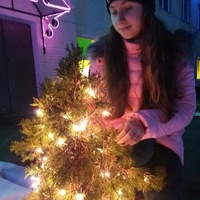
20 БАЛЛОВ. ответить на все. 1. What causes global warming? A. the Earth B. CO2 C. water 2. A “
footprint “ A. Affects daily activities. B. Measures CO2. C. Is usually one size. 3. What is a “no-no “ at school ? A. Plastic lunch bags B. Note paper C. Old pens 4. What can you do to save energy? A. Never use air conditioners B. Switch off lights when not in use C. Use your PC outside 5. Which is the “greenest” form of getting around? A. Your feet B. The bus C. The car 6. Reduce waste by A. Throwing things out. B. Repairing things. C. Reusing broken things. 0
0
 0
0
Ответы на вопрос
 Внимание! Ответы на вопросы дают живые люди. Они могут содержать ошибочную информацию, заблуждения, а также ответы могут быть сгенерированы нейросетями. Будьте внимательны. Если вы уверены, что ответ неверный, нажмите кнопку "Пожаловаться" под ответом.
Внимание! Ответы на вопросы дают живые люди. Они могут содержать ошибочную информацию, заблуждения, а также ответы могут быть сгенерированы нейросетями. Будьте внимательны. Если вы уверены, что ответ неверный, нажмите кнопку "Пожаловаться" под ответом.

Ответ:
1A
2A
3c
4B
5A
6B
последный не уверен
 0
0
 0
0

1. What causes global warming?
A. the Earth - This is not the primary cause of global warming. While Earth's position in the solar system does influence its overall temperature, global warming is primarily driven by human activities.
B. CO2 - Correct. Carbon dioxide (CO2) and other greenhouse gases are the main drivers of global warming. These gases trap heat in the Earth's atmosphere, leading to a rise in global temperatures.
C. water - Water, in its various forms, can contribute to climate processes, but it is not the primary cause of global warming.
2. What is a "footprint"?
A. Affects daily activities. - This is a vague description of a footprint and does not capture its true meaning.
B. Measures CO2. - A "footprint" in the context of environmental impact usually refers to an ecological or carbon footprint, which measures the environmental impact of a person's or organization's activities, but it doesn't directly measure CO2.
C. Is usually one size. - This is not a relevant description of a footprint. The correct answer should be something like "A measure of one's impact on the environment."
3. What is a "no-no" at school?
A. Plastic lunch bags - Using plastic lunch bags is discouraged at schools due to environmental concerns, but this is just one example.
B. Note paper - Note paper is commonly used at schools, so it's not typically a "no-no."
C. Old pens - Old pens can often still be used and are not necessarily a "no-no."
4. What can you do to save energy?
A. Never use air conditioners - While minimizing the use of air conditioners can save energy, this is a bit extreme. Air conditioners can be used efficiently to save energy.
B. Switch off lights when not in use - Correct. Turning off lights when they are not needed is a simple and effective way to save energy.
C. Use your PC outside - Using your PC outside has more to do with personal preference than saving energy, and it doesn't directly relate to energy conservation.
5. Which is the "greenest" form of getting around?
A. Your feet - Correct. Walking is the most environmentally friendly mode of transportation as it produces no emissions and has a minimal ecological footprint.
B. The bus - Public transportation like buses can be more environmentally friendly than cars, but it still generates some emissions.
C. The car - Using a personal car is typically less environmentally friendly than other options, as it contributes to pollution and congestion.
6. Reduce waste by
A. Throwing things out. - This is the opposite of reducing waste. It contributes to waste and pollution.
B. Repairing things. - Correct. Repairing items instead of throwing them away helps reduce waste and conserves resources.
C. Reusing broken things. - Reusing broken items after they are repaired is a sustainable practice that helps reduce waste. So, this is also correct.
 0
0
 0
0
Похожие вопросы
Топ вопросов за вчера в категории Английский язык
Последние заданные вопросы в категории Английский язык
-
Математика
-
Литература
-
Алгебра
-
Русский язык
-
Геометрия
-
Английский язык
-
Химия
-
Физика
-
Биология
-
Другие предметы
-
История
-
Обществознание
-
Окружающий мир
-
География
-
Українська мова
-
Информатика
-
Українська література
-
Қазақ тiлi
-
Экономика
-
Музыка
-
Право
-
Беларуская мова
-
Французский язык
-
Немецкий язык
-
МХК
-
ОБЖ
-
Психология
-
Физкультура и спорт
-
Астрономия
-
Кыргыз тили
-
Оʻzbek tili
























